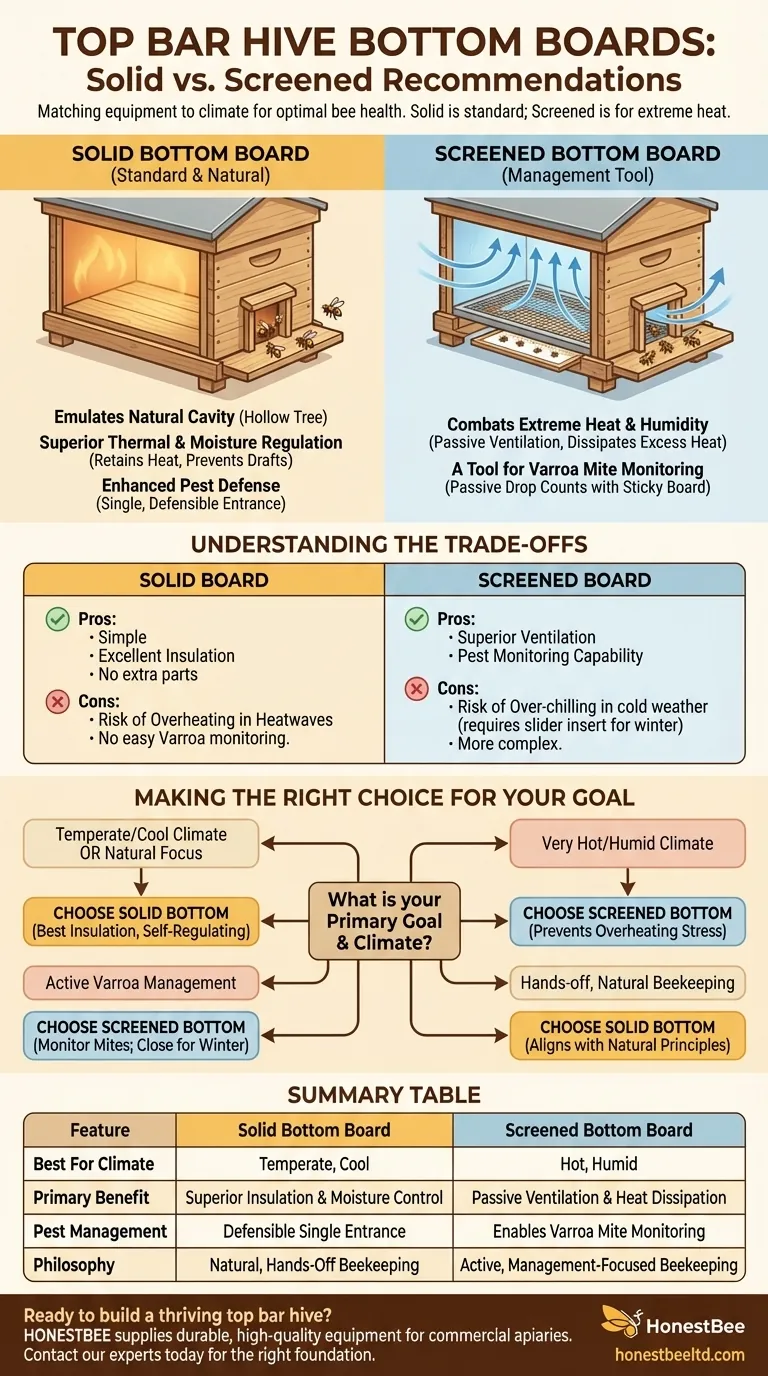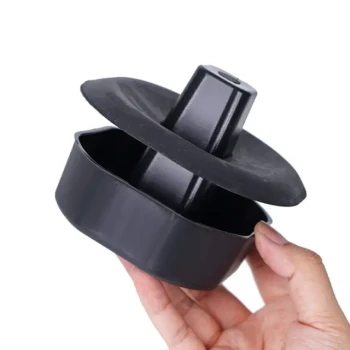For top bar hives, the standard and most common recommendation is a solid bottom board. This design choice is rooted in emulating the bees' natural habitat, allowing the colony to better control its own temperature and humidity. While a solid bottom is the default for most climates, a screened bottom board can be a critical tool in regions with extreme heat and humidity.
The choice between a solid and screened bottom board is not about which is universally "better," but about matching your equipment to your specific climate. Your goal is to help the bees manage their internal environment—primarily temperature and moisture—with minimal stress.

The Case for the Solid Bottom Board
A solid bottom board is the traditional choice for top bar hives, and for good reason. It aligns closely with the principles of natural beekeeping by creating an environment that the bees can manage themselves.
Emulating a Natural Cavity
In nature, honey bees build their homes in enclosed cavities like hollow trees. A solid bottom board on a top bar hive best mimics this natural state, providing a sealed, insulated floor.
This design gives the colony maximum control over its internal atmosphere, allowing the bees to heat, cool, and ventilate the space according to their own needs.
Superior Thermal and Moisture Regulation
A solid bottom prevents drafts, which is crucial for the colony's ability to maintain the stable, warm temperature (around 95°F or 35°C) required to raise brood.
In temperate or cool climates, a screened bottom can allow too much cold air to enter, chilling the brood nest and forcing the colony to expend excess energy just to stay warm. A solid bottom helps conserve this vital heat.
Enhanced Pest Defense
A top bar hive with a solid bottom typically has a single, smaller entrance. This creates a highly defensible chokepoint that the guard bees can easily protect from robbing bees, wasps, and other intruders.
When to Consider a Screened Bottom Board
While solid boards are the standard, screened bottoms serve an important purpose in specific situations. They are less about emulating nature and more about providing a management tool for the beekeeper.
Combating Extreme Heat and Humidity
In very hot and humid climates, such as the southeastern United States, overheating can be a serious threat. A screened bottom board provides essential, passive ventilation that helps the colony dissipate excess heat and moisture.
This ventilation can prevent the bees from having to "beard" outside the hive in large numbers and helps with the evaporation of water from nectar during the honey-making process.
A Tool for Varroa Mite Monitoring
Screened bottom boards are a key component of Integrated Pest Management (IPM). By inserting a removable "sticky board" underneath the screen, you can conduct passive mite drop counts.
This allows you to monitor the level of Varroa mite infestation in the hive without disturbing the colony, helping you make informed decisions about when treatment is necessary.
Understanding the Trade-offs
Neither option is a perfect solution for all scenarios. Understanding their respective strengths and weaknesses is key to making an informed decision.
Solid Board: Simplicity vs. Limited Ventilation
A solid bottom is simple, requires no extra parts, and offers excellent insulation. However, in a heatwave, it can contribute to an overheated hive and provides no easy way to monitor natural Varroa mite fall.
Screened Board: Versatility vs. Climate Risk
A screened bottom offers superior ventilation and pest monitoring capabilities. Its biggest downside is the risk of over-chilling the colony in cooler weather, which can stress the bees and harm the brood. Many beekeepers use a removable insert or "slider" to close the screen during fall and winter, adding an extra management task.
Making the Right Choice for Your Goal
Your decision should be based on your local environment and beekeeping philosophy.
- If you are in a temperate or cool climate: Start with a solid bottom board, as it provides the best insulation and moisture control for the bees' health.
- If you are in a very hot and humid climate: A screened bottom board is the superior choice to prevent colony stress from overheating.
- If your primary focus is hands-off, natural beekeeping: The solid bottom board most closely aligns with this philosophy by creating a self-regulating environment.
- If your primary focus is active Varroa mite management: A screened bottom is an invaluable tool, but be prepared to close it off when the weather turns cold.
Choosing your bottom board is about aligning the hive's design with your local environment to give your bees the best possible start.
Summary Table:
| Feature | Solid Bottom Board | Screened Bottom Board |
|---|---|---|
| Best For Climate | Temperate, Cool | Hot, Humid |
| Primary Benefit | Superior Insulation & Moisture Control | Passive Ventilation & Heat Dissipation |
| Pest Management | Defensible Single Entrance | Enables Varroa Mite Monitoring |
| Philosophy | Natural, Hands-Off Beekeeping | Active, Management-Focused Beekeeping |
Ready to build a thriving top bar hive?
Choosing the right equipment is the first step to a healthy, productive colony. At HONESTBEE, we supply durable, high-quality beekeeping supplies and equipment to commercial apiaries and distributors.
Let us help you build a stronger operation. Contact our wholesale experts today to discuss your needs and get the right foundation for your success.
Visual Guide

Related Products
- Langstroth Solid Bottom Board for Beekeeping
- Langstroth Screen Bottom Board for Beekeeping Wholesale
- Australian Pine Wood Langstroth Screen Bottom Board for Wholesale
- HONESTBEE Professional Long Handled Hive Tool with Precision Cutting Blade
- HONESTBEE Classic Pry Bar Hive Tool with High Visibility Finish for Beekeeping
People Also Ask
- What are the characteristics of a solid bottom board? A Guide to Hive Foundation & Climate Control
- How do honeybees adapt to different bottom board types in terms of temperature regulation? Optimize Your Hive Climate
- What is the suggested approach for choosing hive boards if you have only 1 or 2 hives? Test Both Types to Find Your Perfect Fit.
- How is the solid bottom board constructed to ensure durability? Built for Longevity with Quality Wood & Beeswax
- What frame setups are available for the solid bottom boards? Choose the Right Foundation for Your Hive



















